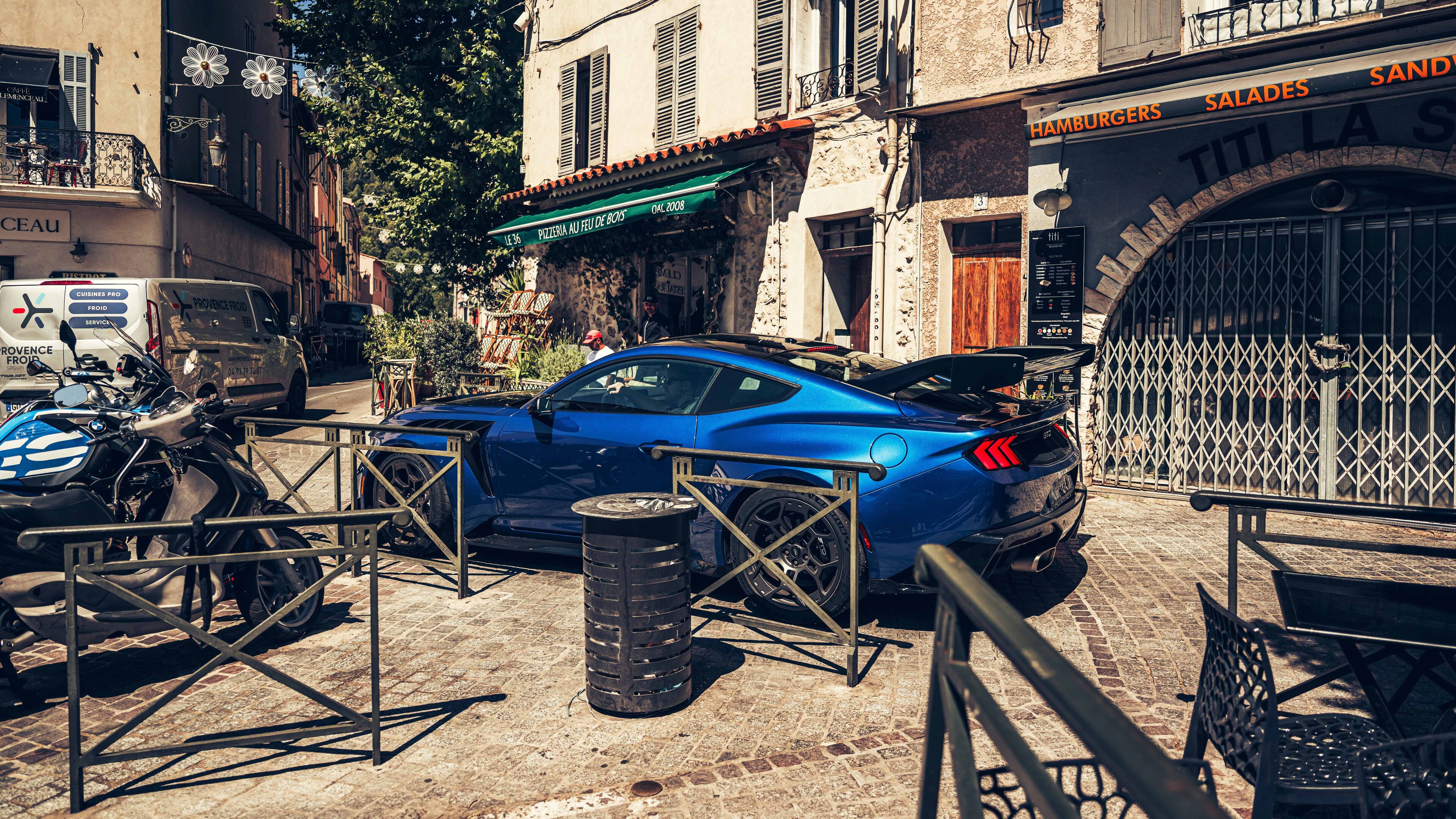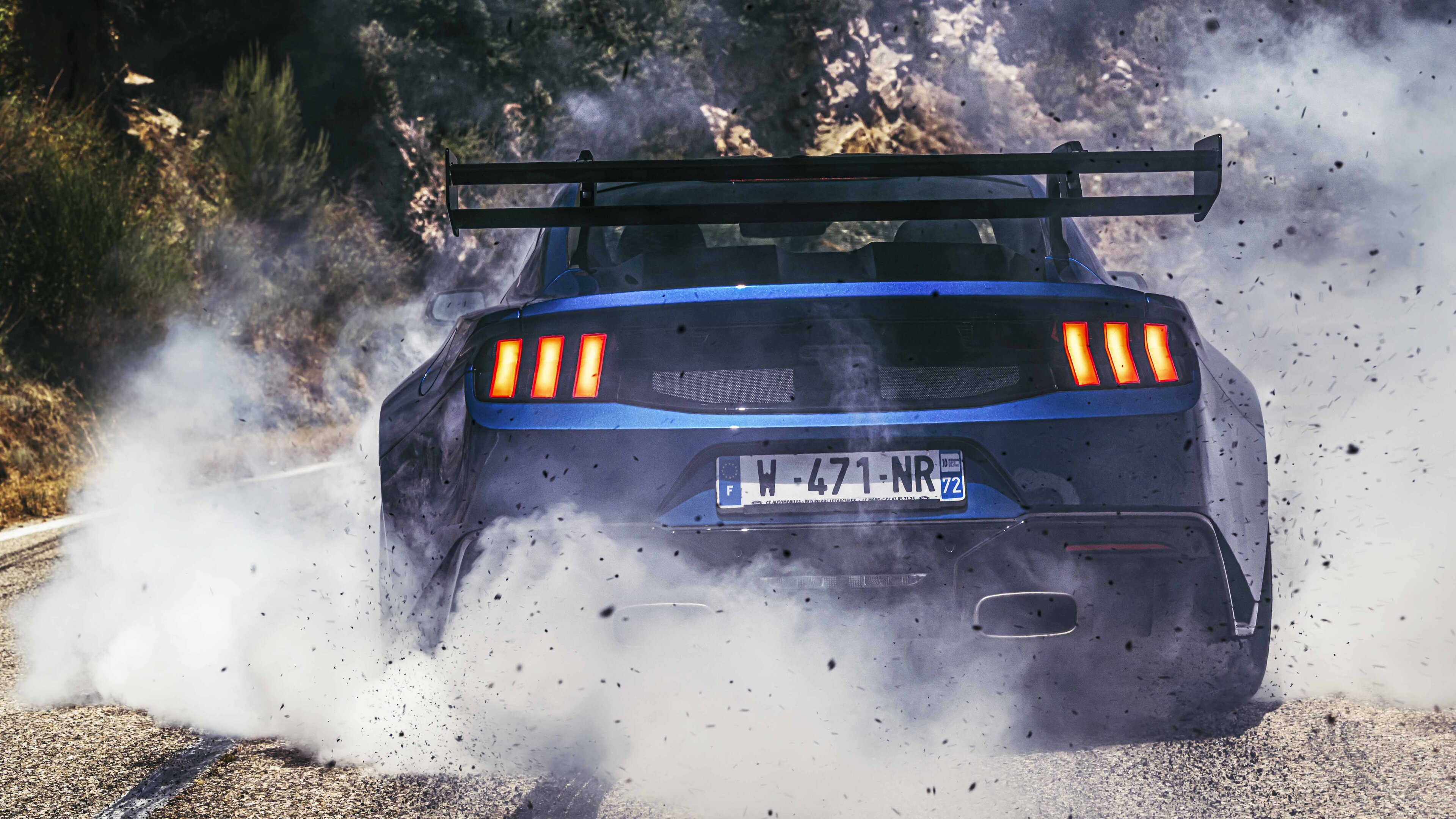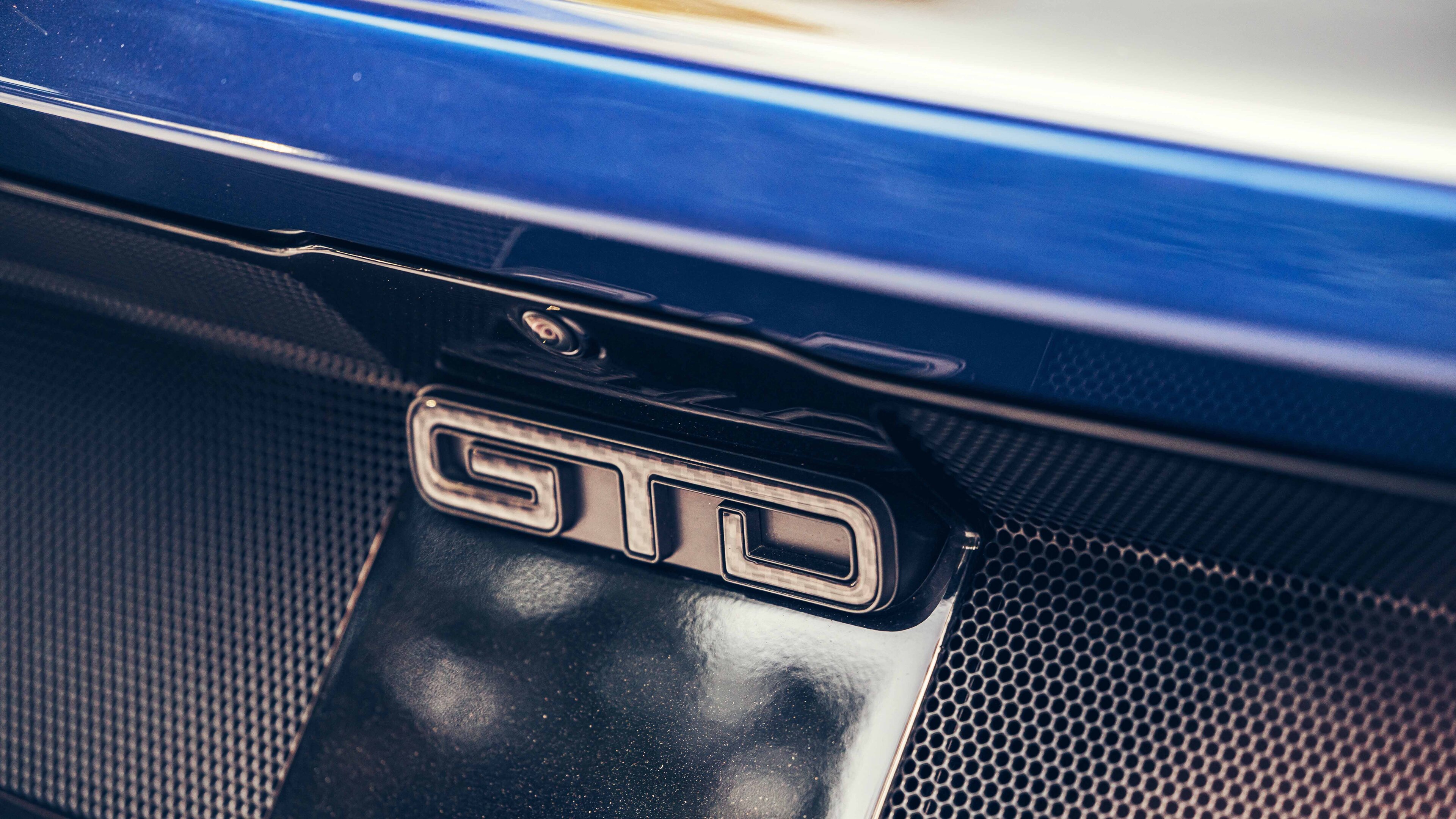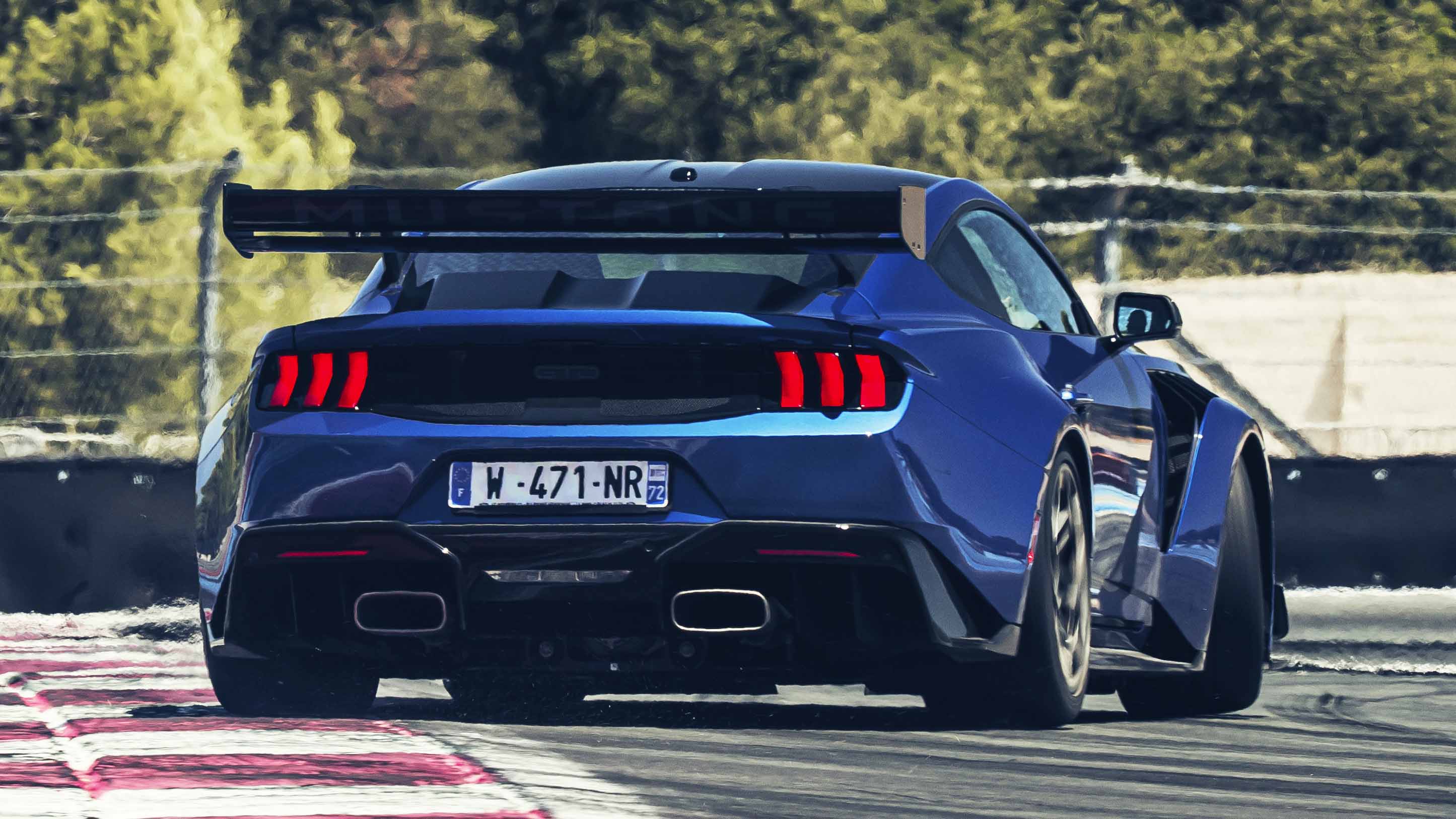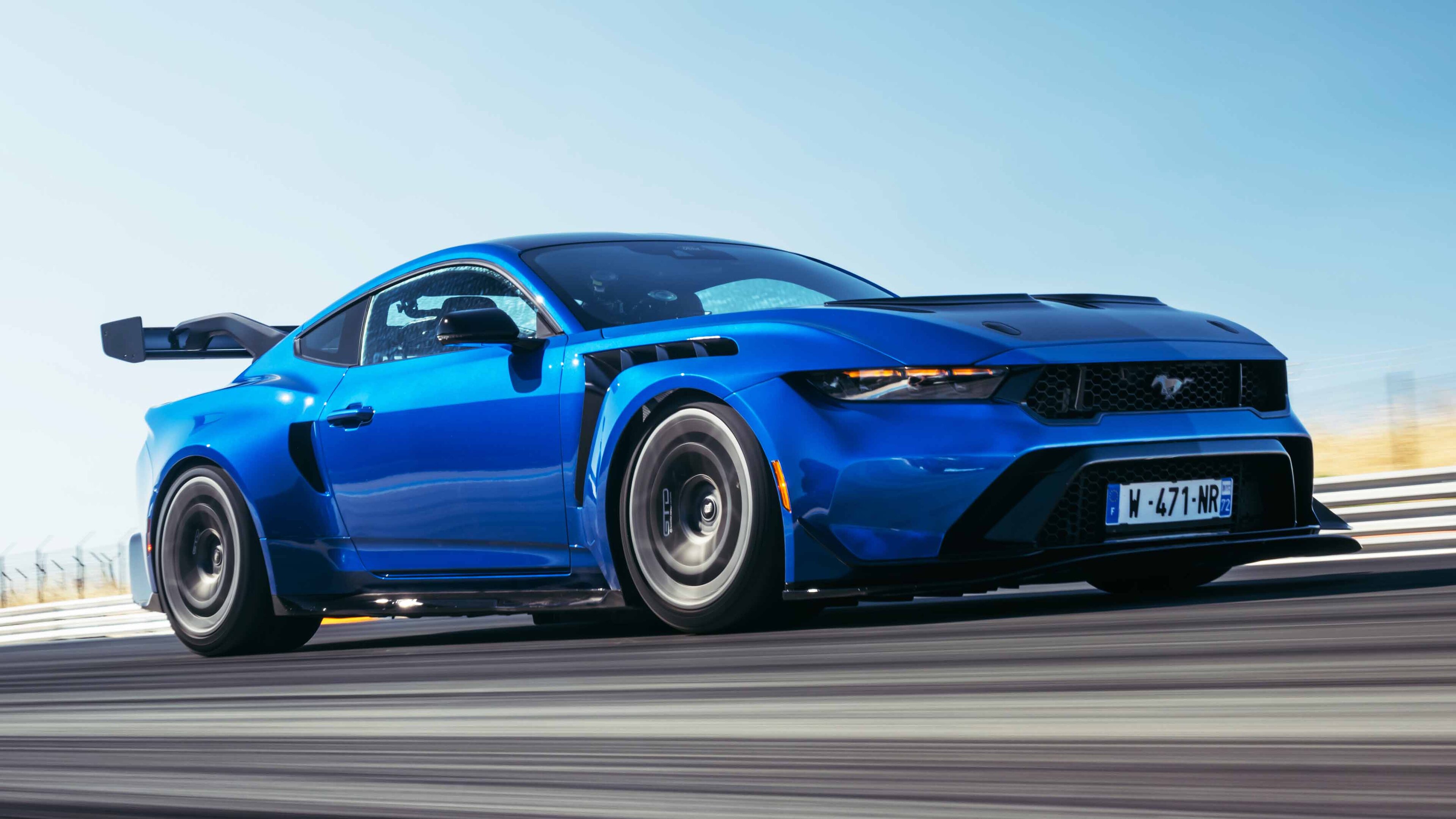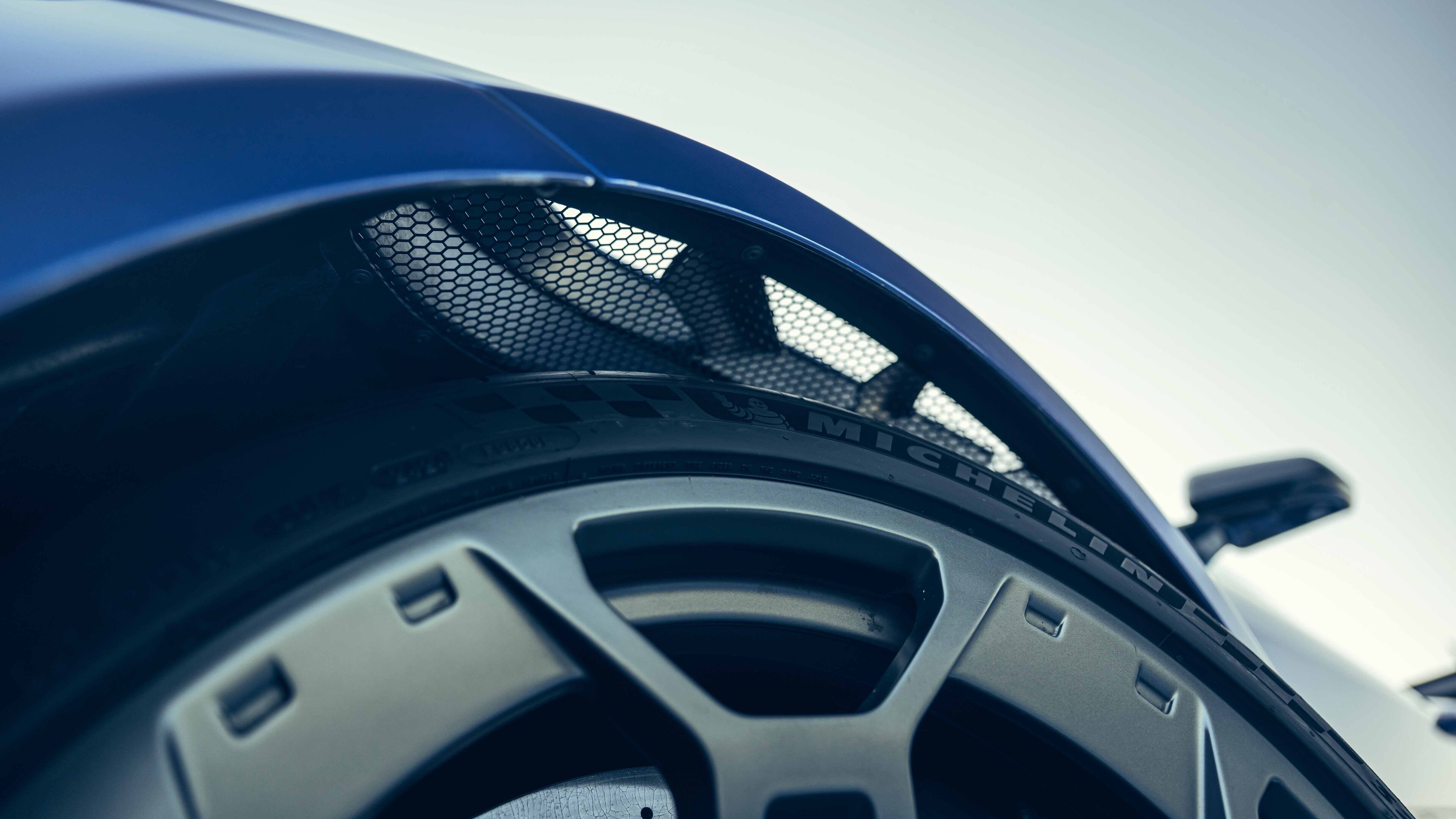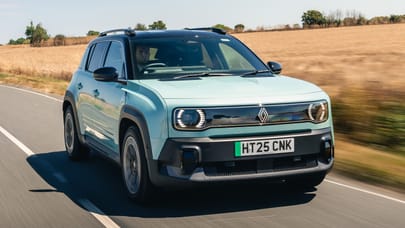
Flat out in the Ford Mustang GTD: unhinged V8 track special is 'a riot to drive'
It's built to take on the surgical Porsche 911 GT3 RS, but offers up something else entirely...
On road
Words: Jack Rix
The Mustang GTD is an all-in kind of car. Nothing by halves. It doesn’t merely rumble, it bellows like Pavarotti with his pipes fully open. Its Popeye bodywork doesn’t just attract your attention, it clubs you on the nose, puts you in a headlock and pins your eyelids open, and it doesn’t lightly grill its tyres... it causes natural disasters. Had I known les pompiers were on high alert for forest fires, perhaps I would have thought twice before sending a plume of smoke off the hillside matched only in height and density by the last eruption of Vesuvius. But here we are being rapped on the knuckles, for playing silly buggers in a car that was designed for precisely that.
To be fair to the teams at Ford Performance and Multimatic that have expelled blood, sweat and expletives to bring this unhinged project into being, it’s also been designed to smash a sub seven minute Nürburgring lap time. That makes it a serious track tool and I’m confident Ollie will uncover the engineering genius beneath it on the circuit tomorrow, but today, on the public road, it’s excess all areas with extra cheese. More engine, more aggression, more width (at 2,080mm, it’s over 150mm wider than a regular Mustang), more noise, more power than I could ever use, which could be frustrating but instead spills over into buckets of character whether you’re pushing hard, lolloping along, or parked up and not moving at all. I’m finding it impossible not to love, which is... surprising.
When you build a road car around a lap time target it rarely trickles down into an engaging and fulfilling driving experience on the road – it mostly translates to lower back pain, but there are a couple of promising signs already. Where you might expect deep, carbon shelled, sadistic race seats with six point harnesses, these Recaros (the only ones you can order) are only mildly bolstered and... squishy. I look forward to Olllie complaining about them later, but right now they’re not just comfortable, they’re giving me the itch to roadtrip. Bizarre.
Same for the roll cage, or lack of it – you’d expect one in a car with this level of track attack, but no. You can actually see out the back, minus a slice of wing, and you’ll find a void for your luggage where the rear seats used to be... which is important, because the boot’s full of the transaxle gearbox and inboard pushrod suspension, viewable doing its horizontal dance through a glazed portal in the back. Top tip: don’t point the rearview mirror downwards to watch it jiggling while you’re driving, it’s hypnotising and you’ll crash immediately.
So the GTD’s engineering is genuinely trick – note the gearbox at the rear for optimum weight distribution, the suspension (similar to a Ford GT’s) which is Multimatic’s hydraulic spool valve setup that instadrops by 40mm in track mode like the car’s been sat on. It lifts the front end rapidly too, which makes sense when you see the size of the front splitter. There’s active aero under there too, synced with the DRS rear wing. Everything is carbon fibre. This isn’t a case of unleash the horsepower and hope, it’s an American hero retrimmed to take on the European elite, and blurs the line completely between muscle car and supercar.
It doesn’t seem to matter much which of the five – yes, five – exhaust modes you put it in. This throbbing 5.2-litre, dry sumped supercharged V8 – producing 815bhp and 664lb ft – is the life and soul of the party. And the reason the cops get called to shut the whole thing down. It makes a primordial, cretaceous noise. Stand and watch as it screeches towards you, supercharger yowling, then thunders past. I realise for Top Gear's US patrons this isn’t exactly new, but for us Brits it’s still a rare treat. And won’t be coming to Europe. This is a US spec setup, European regs demand something tamer. Got one coming? You know what to do.
There’s more than enough finesse and adjustability to make this a deeply fulfilling and consistently amusing car to drive
Looking for more from the USA?
Top Gear
Newsletter
Thank you for subscribing to our newsletter. Look out for your regular round-up of news, reviews and offers in your inbox.
Get all the latest news, reviews and exclusives, direct to your inbox.
Get brave with the throttle and it surges forward, regardless of gear, then cracks the whip when you really get your toe in. It’s less like acceleration, more like a controlled explosion and only enhanced by the brilliance of the dual clutch gearbox’s snap in either direction. Did I mention the paddles were made from 3D printed titanium salvaged from F22 fighter jets? Utterly pointless, but somehow perfect for a car that’s an exaggeration of itself.
As soon as it starts moving, even at low road speeds, it does everything professionally. The damping feels expensive – no wayward movement, no chassis shudder or suspension tremor, no gearbox slack. Nothing like an ordinary Mustang in other words. It rounds off bumps, smooths out rough surfaces and almost never loses its composure, all while feeling strangely luxurious. Weight plays its part there, smothering small stuff, the Mustang rarely thrown off course, but there’s more than enough finesse and adjustability to make this a deeply fulfilling and consistently amusing car to drive.
Yes, it weighs quite a bit, which isn’t ideal, yet you have so much confidence tipping those huge front tyres into corners, getting back on the throttle early and generally having a play. It feels friendly and encouraging, not vindictive and fighting against you. I thought the surgical enhancements would leave a car capable of devouring tracks, but rigid and joyless on the road, but the GTD has confounded my expectations. Buckle up, Ollie, you’re in for a wild one...
Photography: Olgun Kordal
On track
Words: Ollie Marriage
I’m doing 165mph down the Mistral straight, and I think the GTD might be about to pull itself apart. The mirrors have blurred, the bodywork is buzzing, the seats are vibrating, the whole car hums with energy and strain. It feels like the panels are going to peel off, leaving the Mustang GTD raw and exposed in the middle of Paul Ricard.
And I think it might quite like that. It’s quite the extrovert, this car. But you knew that just by looking at it. The width, the stance, the swagger, slats and bulges. Pumped gym rat aesthetic, but done well.
But that’s not enough is it? The peacocking about is all well and good, but this thing is designed to take on Porsche’s 911 GT3 RS, the most steely eyed track machine of them all. We already know it’s in the performance ballpark, since Ford posted its 6m 52s ’Ring lap time. OK, the Porsche went three seconds faster, but that’s not bad. And then you look deeper and realise the Mustang needed an extra 300bhp to go slightly slower and so start asking yourself questions about the car’s dynamic composition.
It’s heavy, that’s the issue here. Ford started with a heavy car... and made it heavier. Now Ford is a bit coy with this, but from what I can tell the GTD is the heaviest Mustang in the range. While various Dark Horse and GT500 versions weigh in at around 1,800kg, this one is 1,930kg. And that’s in its lightest trim. The engineers running the car when I drove it reckoned this one’s only just shy of two tonnes.
And that takes some managing. You don’t have to look far to see where the first bit of reinforcing has been done. The front tyres are 325 section (pretty much the same width the Porsche wears at the back). As you’d hope, it’s got immense front end grip. Immense. One of the stars of the show for me was the bite it had on the way into fast corners, the sheer appetite for an apex.
Then there are the dampers. Get up close to the porthole and you realise how outsize they are, like the pistons off steam trains. And so it continues around the car – brakes, splitter, vents... it’s not just the wing that’s ginormous. And all necessarily huge to support the weight, which climbs because the components are big and so on and so forth.
I clamber in and settle into the huge seat, peer out over a significant acreage of bonnet, but far from being perturbed, I’m excited. I’ve seen and heard this thing on the move and it looks wild. Feels pretty wild too, I think as the speedo crests 165mph about midway along Paul Ricard’s 1.2 mile back straight and the shaking starts. It doesn’t feel like it’s going to shake itself to bits, more that it’s making you aware of the tension and effort it’s putting itself through. It feels alive.
It nudges 180mph before I hit the brakes. Oh my God, they’re sensational. Wouldn’t mind a firmer, shorter pedal, but the stopping power is ridiculous. I mentally pack away any concerns about the weight. And then I’m into the corners. I’m not expecting sensational steering feedback and I don’t get it, there’s not a great deal of sensitivity there, but it’s crisp enough to give me faith. No lag or delay from the supercharged V8, just massive, instant torque and a constant barrage of cackling, gargling and roaring.
But it’s not just grip, force and noise. You don’t get Multimatic involved without good reason, nor do you allow it to root through the fundamentals of the car, designing an all new rear subframe to take the bespoke suspension and rear transaxle gearbox that has the further benefit of handing the GTD a 50:50 weight distribution. The work the firm’s done has turned the GTD into something a world away from any other Mustang. They tend to be cars dominated by their engines, with the chassis doing its best to contain the torque. The GTD can take everything the mighty motor can throw at it.
I’m having a better time out here than I would be in just about anything else and hang the lap times
It’s not just the rigidity of the chassis or the absorbency of the suspension, it’s that the car feels so well balanced, with front and rear axles so connected. The rival it reminds me most of is AMG’s GT Black Series, a proper locked down, race inspired, GT3 RS adjacent track machine. This is more playful, has a larger handling sweet spot, and a gung ho attitude that I can’t get enough of. Where the GT3 RS satisfies the detail geek in all of us, the GTD delivers earthier pleasures.
I thunder around Paul Ricard, bodywork vibrating, brakes pounding, engine roaring and reckon I’m having a better time out here than I would be in just about anything else and hang the lap times. Because who cares, really? The gearshifts punch hard and fast, it’s physical to drive, you feel the tension in the car and it manages its weight well, only starting to struggle when the heat build up starts to wilt the brakes and tyres. But by then the fuel tank is empty. It’s got a thirst on it like nothing else, the GTD – 50 miles and it’s parched.
Some notes. It’s not a dancer, doesn’t switch direction like the Porsche, isn’t as locked down. It needs a set of burlier, more figure hugging seats. And probably a roll cage. Neither is on the options list as Ford says there are plenty of aftermarket firms to sort that out for you. And as Jack mentioned, if you’re buying one in Europe, you don’t get this US spec exhaust, but a more timid one.
Yeah, a GT3 RS is purer, more communicative while this, with its thunderous engine and indulgent chassis is a riot to drive, the antithesis to so much modern motoring. Some will be sniffy about it, thinking it doesn’t have the right badge, the right engine, the right image. But they’ll be missing out. Because it’s made of the right stuff.
Ford Mustang GTD
Price: £315,000
Powertrain: 5163cc supercharged V8, 815bhp, 664lb ft
Transmission: 8spd DCT, RWD
Performance: 0–62mph in 3.2secs, 202mph
Nürburgring time: 6:52.072
Economy: 14.4mpg, 460g/km CO2
Weight: 1,930kg








